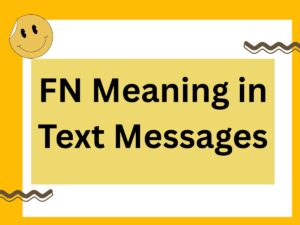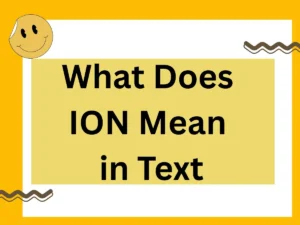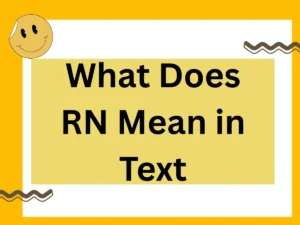In a fast-scrolling, notification-filled digital world, abbreviations aren’t just convenient — they’re essential. “TMI” is one of those three-letter acronyms that pops up in messages, tweets, DMs, and even in spoken conversation. But while many understand it as shorthand for “Too Much Information,” its meaning, tone, and impact have evolved significantly in 2025.
🔥 Rizz Line Generator 🔥
In this comprehensive guide, we’ll explore everything you need to know about “TMI” — from its nuanced connotations in different contexts to polished alternatives you can use when the situation calls for something more tactful. You’ll also get examples you can directly adapt, plus tips for making the right word choice based on audience and platform.
Meaning of “TMI” in Text
TMI stands for Too Much Information. It’s most often used to indicate that the other person has shared more personal, graphic, or unnecessary detail than the listener or reader wanted to hear.
However, in 2025, the meaning isn’t as narrow as it once was. While the original usage was often humorous or slightly embarrassed (“That’s more than I needed to know!”), it’s now also used:
- Playfully: among friends sharing quirky overshares.
- Gently: to signal oversharing without shaming someone.
- Seriously: to set personal boundaries or stop uncomfortable discussions.
- Self-referentially: when the speaker warns the audience they’re about to give more detail than usual (“TMI, but here’s what happened…”).
Origin and Evolution
While “TMI” first gained traction in early internet chatrooms and forums in the late 1990s, it exploded into mainstream usage in the mid-2000s with the rise of texting and social media. By 2010, it was entrenched in everyday digital language, appearing in memes, reality TV, and pop culture scripts.
In 2025, “TMI” has expanded into nuanced territory:
- Corporate Comms: Used sparingly, often humorously, in internal chats to lighten tone.
- Digital Therapy & Wellness Spaces: Acknowledged as a light, non-judgmental way to discuss boundaries around personal sharing.
- Social Media: Has become a hashtag (#TMI) used for candid, overshare-style storytelling posts.
Why “TMI” Still Works in 2025
- Brevity – It’s quick to type and instantly understood.
- Tone Flexibility – Works for both humor and polite redirection.
- Emotional Buffer – Softer than bluntly saying, “That’s inappropriate.”
- Cross-Platform Recognition – Known equally in texting, TikTok captions, Slack, and Instagram Stories.
The Nuance of Tone: When “TMI” Helps vs. Hurts
The difference between friendly banter and offense often comes down to tone, relationship, and platform.
- Friendly tone: “Haha, TMI, but now I can’t unhear that!”
- Boundary-setting tone: “That’s a bit TMI for me—let’s change the topic.”
- Self-aware tone: “Okay, TMI incoming, but you asked…”
Pro Tip (2025): Use emojis strategically. A smiley or laughing face after “TMI” can instantly make it lighter. Without it, your message could come across as cold or critical.
Polite, Professional, and Casual Alternatives to “TMI”
While “TMI” works well informally, in professional or sensitive situations you might want to swap it out for something that maintains tact while respecting boundaries.
Polite / Formal Alternatives
- “That’s more detail than I need right now.”
- “I appreciate your openness, though I’m not comfortable discussing that.”
- “Perhaps we can focus on the main points.”
Professional / Semi-Formal Alternatives
- “That’s getting a bit off-topic—let’s keep to the agenda.”
- “Let’s stick to the key facts for now.”
- “I think that might be more information than necessary for this discussion.”
Casual / Informal Alternatives
- “Okay, that’s more than I bargained for!”
- “Too much info, my friend.”
- “Wow, didn’t need that visual!”
How to Choose the Right Alternative
When deciding between “TMI” and another phrase, consider:
- Audience – Friends and close contacts can handle informal shorthand. Clients or superiors may not.
- Relationship – The closer the rapport, the more playful you can be.
- Setting – Public platforms may require softer language to avoid misunderstanding.
- Purpose – Are you teasing, redirecting, or setting a firm boundary?
10 Example Sentences That Stand Out
Here are ten varied examples showing how “TMI” and its alternatives fit different tones and contexts:
- Playful friend chat:
“Haha, TMI, but now I totally understand why you hate that song.” - Friendly warning:
“TMI incoming—this story gets weird.” - Professional meeting redirect:
“That’s a bit more detail than we need for this decision—let’s focus on the summary.” - Boundary-setting in text:
“That’s a bit TMI for me—can we switch topics?” - Casual overshare reaction:
“Whoa, too much info, but thanks for the laugh.” - Social media caption:
“#TMI but my cat just learned how to open the fridge.” - Humorous group chat:
“Yikes, didn’t need that visual—classic TMI moment.” - Professional politeness:
“That may be more information than necessary at this stage.” - Self-deprecating storytelling:
“This is going to be TMI, but it’s too funny not to share.” - Text to family:
“TMI, Dad! But… I guess that’s what families are for.”
Advanced 2025 Insights: TMI in Digital Culture
Through recent communication studies and AI-assisted sentiment analysis, several patterns in “TMI” usage have emerged in 2025:
- Context Softening – Emojis or GIFs are often paired with “TMI” to signal humor rather than offense.
- Increased Self-Tagging – People preface their own posts with “TMI” to invite consent from readers before oversharing.
- Algorithmic Relevance – On platforms like TikTok and Instagram, posts tagged with “#TMI” tend to get higher engagement in relatable storytelling categories.
- Global Adoption – While “TMI” is predominantly English-language slang, it’s now recognized in multilingual spaces and sometimes adapted phonetically in other scripts.
The Psychology Behind “TMI”
Linguistically, “TMI” functions as both:
- A meta-commentary (about the act of sharing itself).
- A social boundary marker (showing comfort or discomfort levels).
In psychology, these small linguistic cues help:
- Preserve relationships by avoiding direct confrontation.
- Maintain personal comfort while still validating the speaker.
- Signal group belonging through shared internet slang.
Common Mistakes When Using “TMI”
- Overusing it in formal settings – can sound dismissive.
- Using it without clear tone markers – risks coming off as cold.
- Applying it to serious disclosures – may seem insensitive to vulnerable information.
Final Takeaway
“TMI” remains relevant in 2025 because it’s adaptable, socially intuitive, and instantly recognizable.
The key to using it well is tone awareness and audience sensitivity. Whether you keep it playful or replace it with a more formal alternative, the goal is the same: to navigate oversharing gracefully.





